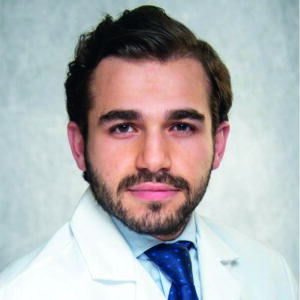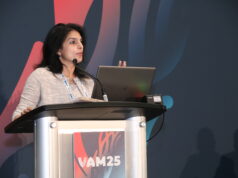Conflicting results open fresh debate around effect of vein harvesting technique on long-term patency of lower extremity bypass grafts.
Two separate analyses that looked at the impact made by the method used to harvest great saphenous vein (GSV) on the long-term patency of lower extremity arterial bypasses demonstrated markedly different results over the issue of whether open harvest was superior to the endoscopic approach.
One, a collaborative effort between the University of Iowa in Iowa City and Henry Ford Hospital in Detroit, was drawn from Vascular Quality Initiative (VQI) data and showed that a lower postoperative wound complication rate when performing endoscopic harvest of GSV over the open approach came at the expense of worse long-term patency outcomes. The other, from a research team at Wright State University in Dayton, Ohio, probed an institutional experience, reporting no significant difference in patency rates between the two techniques. Both sets of results were delivered at the 2024 Midwestern Vascular Surgical Society (MVSS) annual meeting in Chicago (Sept. 12–14).
The former, delivered by Mohamad Chahrour, MD, a vascular surgery resident at the University of Iowa and previously a general surgery resident at Henry Ford, won the John R. Pfeifer Best Venous Paper Award.
The use of endoscopic vein harvest for lower extremity bypass remains a contentious issue in vascular surgery over possible damage caused to the harvested GSV, with open harvest the preferred method in the absence of robust evidence favoring either technique.
Superiority of open approach?

Amid this ongoing debate, Chahrour and colleagues sought to compare outcomes between the two approaches and determine whether there has been any improvement in endoscopic harvest outcomes over time.
They plumbed VQI lower extremity infrainguinal bypass registry data from 2011–2023, propensity matching 7,929 open harvest patients to 2,643 subjects who underwent endoscopic harvest.
Short-term outcome data revealed open harvest was associated with an increased rate of surgical site infection and higher length of stay, procedure time and estimated blood loss.
However, Chahrour told MVSS 2024, open harvest was superior in terms of both primary and secondary patency: At one-year follow-up, the primary patency rate was 71% for open vs. 65% for endoscopic harvest; secondary patency 90% vs. 85%; and major adverse limb events (MALE) 25% vs. 30%.
“We performed a subgroup analysis in which we looked at the outcomes based on the outflow target,” Chahrour said. “Endoscopic harvest was again associated with worse outcomes regardless of the target vessel, with almost 25–50% increased odds of loss of primary patency at one year.”
On the other hand, the analysis revealed that endoscopic harvest outcomes improved over time. Primary patency went from 59% in 2011, gradually increasing to reach 70% in 2020. “This could be due to advanced technologies in the new endoscopes or due to experience accumulated by the vein harvesters,” Chahrour said.
“When we compared outcomes based on technique by years, we saw that open was superior in the first half and became equivalent in the second half. We started with a 13% difference in patency in 2011 and, in 2020, we saw a difference of 3%, which was non-statistically significant. However, it is important to note that this comparison is between unmatched and unadjusted samples and that those findings should be analyzed with caution.”
Concluding, Chahrour said the study demonstrated endoscopic harvest’s association with improved short-term outcomes but “open vein harvest was associated with improved long-term outcomes, both with increased patency and increased limb salvage,” he said, adding: “Endoscopic vein harvest is improving with new technologies and more experience. We believe a repeat outcomes analysis will be needed to reflect those advances in the future.”
Conversely, no significant differences?

The analysis of Wright State University’s institutional experience, meanwhile, showed conflicting results. Presenting the data, Justin Robbins, MD, Wright State University’s chief general surgery resident, pointed toward endoscopic GSV harvesting’s mid- 1990s roots and now widespread use in coronary artery bypass grafting (CABG).
Studies exploring its applicability in lower extremity bypass grafting have so far produced mixed results, with some showing decreased patency and others reporting no change, Robbins said.
He highlighted a 2021 Journal of Vascular Surgery meta-analysis—which contained 12 comparative studies—that found “a significant decrease” in patency rates with endoscopic harvest.
“Of note, the last study that was conducted was in 2019, from a single center, and they found no difference in patency rates among the two groups [open and endoscopic], and they attributed this significantly to provider experience with endoscopic harvest,” Robbins said.
The Wright State University researchers sought to catalogue their institutional experience with endoscopic harvest and its impact on patency in light of their retention of a highly experienced vein harvester as part of their vascular surgery team.
The retrospective study encompassed 340 chronic limb-threatening ischemia [CLTI] patients undergoing infrainguinal bypass with GSV from 2013–2023—111 through open harvesting of the vein and 229 endoscopically. The experienced harvester, a physician assistant (PA) who spent two decades in cardiothoracic (CT) surgery, where the PA performed endoscopic harvesting for coronary bypasses, has been a part of the Wright State vascular team for seven years.
Robbins and colleagues found no difference in need for arterial surgery within one or five years, as well as no difference in need for amputation. “However, there was a significant difference in incision breakdown, 12% [for endoscopic harvest] vs. 21%; surgical site infection, 25% vs. 71%; and procedure duration, which was shorter by half an hour at least for endoscopic harvest.”
When looking at patency rates, Robbins said there was no difference between open and endoscopic harvest for primary, primary-assisted or secondary patency.
“We feel that, with experienced providers, endoscopic harvest can be a safe option for great saphenous vein harvest for lower extremity arterial bypass,” Robbins concluded. “However, it is unrealistic to believe that every vascular program can hire someone with 20 years endoscopic harvest experience.
“It’s important to collaborate with CT surgery groups in your institutions if this is something you want to do, because those providers are going to need the experience with short-segment harvest, where they can make those errors. With some of the previous CT surgery studies, they have shown that less experienced providers more likely injure at the junction of the ostium when they’re doing endoscopic harvest. In our group, we saw no effect on patency up to five years and decreased wound complications.”
Contradictory findings come under scrutiny
Jill Colglazier, MD, program director of the vascular surgery integrated residency at the Mayo Clinic in Rochester, Minnesota, who was a moderator of the MVSS session in which the Wright State paper was presented, asked Robbins if he was able to explain the apparent contradictions between the two studies.
Robbins said he had noted during Chahrour’s presentation the previous day that, “when [the University of Iowa-Henry Ford group] looked at [the VQI registry] patency rates, they also noted, as the years went on, that patency rate difference decreased, and they feel that could have been a possible correlation.”
At Wright State, on the other hand, the vascular surgery group used the same provider for each of their cases of endoscopic vein harvest for lower extremity bypass.
Alexander D. Shepard, MD, one of the University of Iowa-Henry Ford paper authors and a Henry Ford Health vascular surgeon, opined that the Wright State study was “a good example of what happens with increased operator experience,” but said he maintained a skepticism of endoscopic harvest. “I think it’s getting better and better, but my concern is with the marginal vein,” he added.
For his part, under questioning after presenting the VQI data, Chahrour tackled the issue of a vein harvester’s experience level. “Because the VQI doesn’t allow for that variable, how do you think you can mitigate that bias, since I think that is probably the number one determinant of the outcome?” he was asked by one attendee.
“For CABGs, there were two trials in the New England Journal of Medicine [NEJM] around 2009 that showed superior outcomes with open [harvest]; the only difference was in the REGROUP trial [looking at open vein harvesting for CABG] of 2019 [in which] they only allowed the experienced harvesters,” answered Chahrour. “So, the first take-home message from that was, if we are going to adopt an endoscopic vein harvest method, then we have to get the PAs to harvest the veins because they are more experienced.”











